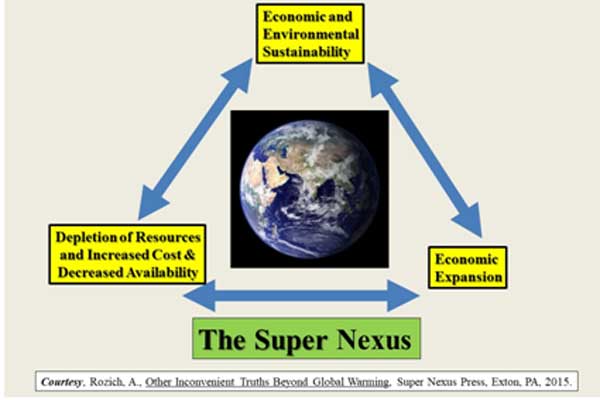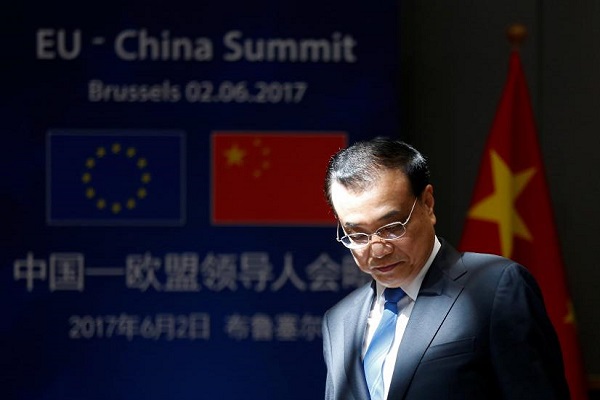China is installing new production systems for energy at a rate of about 2 QUAD (quadrillion BTUs)/yr, mostly as solar and wind (Asian Economies, Not Concern over Global Warming, End Fossil Fuel Dominance).
Sustainability involves more than simply using renewable resources. It also considers how those resources are delivered or made and the level at which the resources depend on each other.
As interlinkage situations proliferate, they morph into nexus scenarios at local, regional, and global levels. Nexus scenarios are a challenge because the linkages result in an ever-increasing cycle of resource consumption and demand.

As interlinkage situations proliferate, they morph into nexus scenarios at local, regional, and global levels. Illustration: Dr. Alan Rozich, P.E., DEE
China’s renewable energy efforts impact key areas in influencing both the thinking and sustainability including Distributed Energy, Transportation, Resource Interlinkage, and Costs of Renewables.
It is notable that China’s energy initiative is primarily using renewables consisting of solar and wind. These systems can be categorized as either centralized or distributed but they are arguably generally perceived as a distributed resource vehicle.
Although China has had some challenges with the integrity of some microgrids, the potential to migrate to a distributed energy format is still viable. The technical issues of microgrids and distributed energy are solvable.
Demonstrating distributed energy large scale is also important as it will be essential to supply energy for the undeveloped world.
Many of these countries have little or no infrastructure while having exigent energy needs for enhancing societal functionality. Distributed generation systems will clearly have a major role to play in enabling these growing societies to meet their resource needs.
According to the Economist (The Economist, June 14, 2017), the Chinese government is developing a plan to phase out and ban cars that run on fossil fuels. This initiative significantly stimulates the need for alternatives to combustion vehicles with the front-runner being electric vehicles (EV).
Some may opine that electric cars are only as good as the fuel source that is used to generate the electricity. However, EROI values (Fossil Fuel Death) for oil have been plummeting. With EVs that use the grid-supplied electricity, coal is essentially “swapped” for oil.
Coal EROI values are projected to be more stable. Even though coal has its own emissions issues, the combination of using EVs in conjunction with electricity supplied by coal-fired energy plants appears attractive.
When launching a major energy production initiatives such as the Chinese are doing, it is prudent to choose the preferred energy technologies carefully. Selecting a technology that is interlinked to water handicaps the effort.
If the Chinese opted for adding more coal plants instead of considering other options, the water requirements would be crippling. The use of solar and wind energy systems avoids the water interlinkage issue.
China’s huge initiative with solar and wind shows that these technologies can be players at large scale and serve to propel the downward price trends for both solar and wind. A relatively recent article in Greentech Media shows a graph depicting the decrease in the price of solar energy costs.
Since 2009, solar costs have a dropped an impressive 85 percent while those for wind fell by 66 percent (GTM, January 26, 2017). The Chinese effort helps provide additional impetus for these trends.
The Chinese economy continues to expand at rapid rates largely due to the unprecedented upward surge of their middle class which is expected to increase by over 1 billion over a few decades. This circumstance compels China to be at the forefront of sustainability which has put them in a global leadership position.
About the Author
Dr. Alan Rozich was a founder of BioConversion Solutions, LLC (BCS), formerly PMC BioTec. Rozich is a world-renowned expert on biological processes with over 30 years of experience in biological treatment and conversion.












Comments